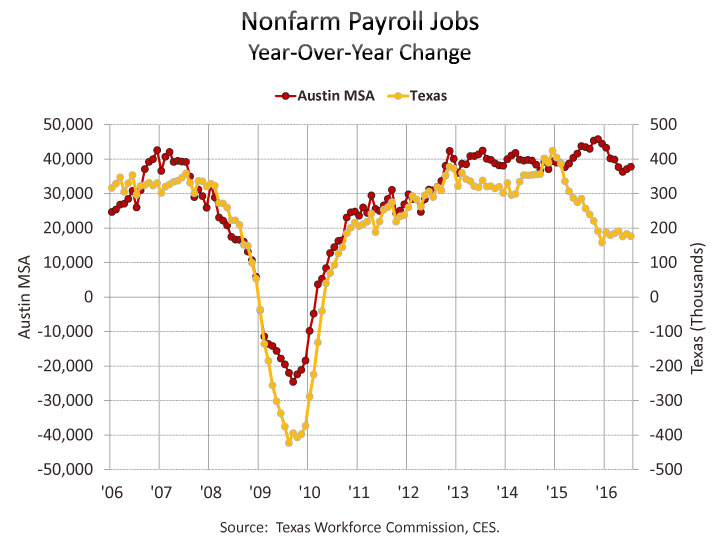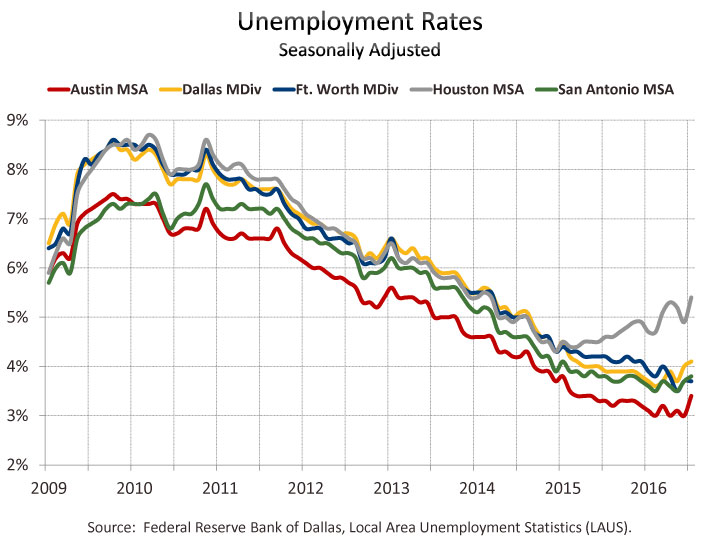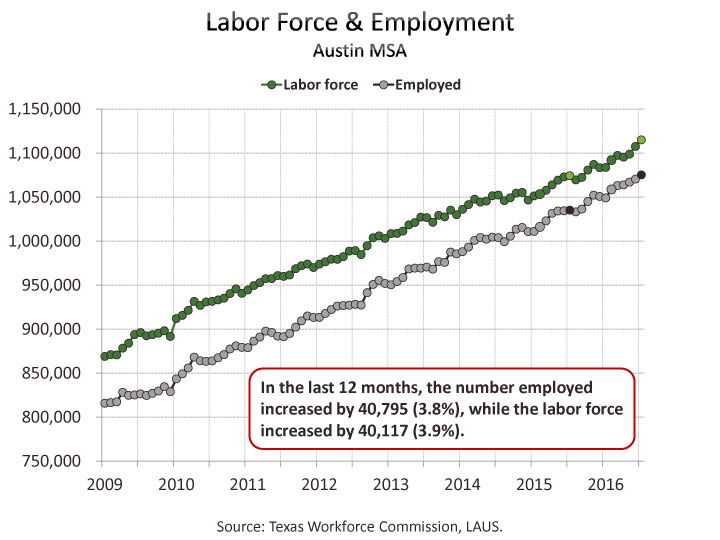Job Growth & Unemployment
Posted on 08/30/2016 by Beverly Kerr
- Austin added 37,800 net new jobs, growth of 3.9%, in the 12 months ending in July, making Austin the third fastest growing major metro.
- Professional and business services added the most jobs (7,900 or 4.9%) in the past year, however, the fastest growing industries are construction and natural resources (12.1%) and wholesale trade (8.9%).
- Austin's seasonally adjusted unemployment rate is 3.4%, up from 3.0% in June.
The Austin metropolitan area added 37,400 net new jobs, or 3.9%, in the 12 months ending in July, according to the recent release of preliminary payroll jobs numbers by the Texas Workforce Commission (TWC) and the U.S. Bureau of Labor Statistics (BLS).
Austin’s 3.9% growth makes it the third best performing among the 50 largest metro areas. Fort Lauderdale and Orlando, growing by 4.6% and 4.1% respectively, topped the ranking. Dallas, at 3.9%, was the fifth fastest growing job market. The other three major Texas metros missed the top 10. San Antonio grew by 1.8% (40th), Fort Worth grew by 1.7% (43rd), and Houston grew by 0.4% (49th) between July 2015 and July 2016. [Rounding growth rates at two decimal places, Austin (3.94%) leads Seattle (3.93%) Dallas (3.87%).]
For the year ending in July, private sector job growth in the Austin MSA is 4.4%, or 35,100 jobs, and with all private industry divisions, except manufacturing, contributing to the growth. Austin's sizable government sector (nearly 18% of jobs) saw modest growth over the last 12 months, gaining 2,700 jobs or 1.6%, thus bringing the overall job growth rate to 3.9%.
Texas saw weaker net private sector job growth of 1.4% with eight of eleven private industry divisions adding jobs over the last 12 months. The government sector, which accounts for over 16% of total state employment, grew faster, 2.3%. Overall job growth was 1.5%. For the nation, private sector growth is 1.9% for the 12 months ending in July, with all private industries, but manufacturing, adding jobs. Overall job growth is a more modest 1.7% because the government sector gained only 0.8%.
Jobs in July are up from June by 2,500 jobs or 0.3% in the not-seasonally-adjusted series for Austin. Job growth from June to July is greater in the seasonally adjusted series—jobs are up by 5,800 or 0.6%. Seasonally adjusted jobs are up 0.3% in Dallas and Fort Worth, up 0.1% in Houston, and down 0.3% in San Antonio. Statewide, seasonally adjusted jobs are up 23,600 or 0.2% in July. Nationally, seasonally adjusted jobs are also up 0.2%.
In Austin, the industry adding the most jobs over the last 12 months is professional and business services which grew by 7,900 jobs, or 4.9%. Construction and natural resources grew fastest at 12.2% (6,900 jobs), followed by wholesale trade at 8.9% (4,300). Also growing at a faster-than-average rate is education and health services (5.0% or 5,600 jobs). Manufacturing lost 5.1% or 3,000 jobs.
Statewide, leisure and hospitality grew fastest, 4.5%, and added 57,000 jobs. Education and health services added the most jobs, 61,800 jobs and grew 3.9%. The other relatively fast growing private industries include wholesale trade (2.5%), financial activities (2.4%), and retail trade (2.3%). Jobs in construction and natural resources lost 33,800 jobs or 3.5% and manufacturing declined by 33,000 or 3.8%. Transportation, warehousing and utilities and information saw slighter declines as well (0.2% and 0.7% respectively) over the last 12 months.
Nationally, education and health services grew fastest, adding 2.8% over the 12 months ending in July. The other industries growing at faster-than-average rates were leisure and hospitality (2.7%), professional and business services (2.6%), and financial activities (2.0%). Manufacturing jobs declined by 0.2%.
The net gain for private service-providing industries in Austin is 31,300 jobs, or 4.6%, over the last 12 months. Employment in goods producing industries is up by 3,800 jobs or 3.3%. Statewide, private service-providing industries are up 202,900 or 2.5%, but goods producing industries are down 66,800 jobs or 3.6%.
We also now have July labor force, employment, and unemployment numbers for Texas and local areas in Texas. The same data for all U.S. metros that we often do a ranking of will not be released until August 31. In June, Austin had the lowest rate of unemployment among the 50 largest metros.
Unemployment numbers for July show Austin’s performance relative to the state and other major Texas metros being sustained. In July, Austin is at 3.6%, while the other major metros range from 4.1% in Dallas to 5.8% in Houston. San Antonio is at 4.2% and Fort Worth is at 4.4%. Austin and San Antonio’s rates are unchanged from a year ago. The rates in Dallas and Fort Worth improved from the rates seen a year ago (by 0.2 and 0.1 percentage points). Houston has seen its unemployment rate increase (from 5.0%). The statewide not-seasonally-adjusted rate is now 5.1%, up from 4.8% in July of last year. The U.S. unemployment rate is 5.1%, improved from 5.6% a year ago.
In 2007, before the impact of the Great Recession, unemployment averaged 3.6% in Austin, 4.3% in Texas, and 4.6% nationally. Unemployment has been at or below pre-recession levels for 18 months in Austin. Texas’ year-to-date average (4.5%) is just above what it averaged in 2007. The nation, with unemployment averaging 5.0% in 2016, has yet to regain its pre-recession level of unemployment.
Within the Austin MSA, Travis County has the lowest unemployment rate in July, at 3.4%, while Caldwell County has the highest at 4.8%. The rate is 3.6% in Williamson County, 3.7% in Hays County, and 4.3% in Bastrop County.
On a seasonally adjusted basis, Austin’s July unemployment rate is 3.4%, up from 3.0% in June. The statewide rate is 4.6%, up from 4.5% in June. Nationally, the seasonally adjusted unemployment rate is 4.9%, unchanged from June.
Among Texas major metros, Fort Worth has the next lowest seasonally adjusted rate at 3.7%, while San Antonio, Dallas, and Houston are at 3.8%, 4.1%, and 5.4% respectively. As with Austin, July rates are up in Dallas, Houston, and San Antonio. Unemployment is unchanged from June in Fort Worth. Seasonally adjusted unemployment rates for Texas metros are produced by the Federal Reserve Bank of Dallas. (The TWC also produces seasonally adjusted rates for Texas metros, but publication lags the Dallas Fed’s data.)
While Austin’s unemployment rate is the same as one year ago, the number unemployed is up by 678 or 1.7%. In July 2016, Austin’s number of unemployed is 39,784, up from 39,106 a year ago. The number of unemployed in Austin averaged more than 60,000 for three years running during the Great Recession.
The Austin metro’s civilian labor force (employed plus unemployed) has increased by 3.8% or 40,795 persons from one year ago, while persons employed increased by 3.9% or 40,117. Texas saw 2.0% growth in labor force and 1.8% in employed, while the number unemployed increased by 7.4% or 46,544. Nationally, July civilian labor force is up by 1.4%, while employed is above the level of a year ago by 1.8%, and 538,000 fewer people (6.1%) are unemployed.
Texas Workforce Commission will release August estimates on September 16.
Also see the Dallas Fed's Texas Employment Forecast released August 19.
The Chamber’s Economic Indicators page provides up-to-date historical spreadsheet versions of Austin, Texas and U.S. data for both the Current Employment Statistics (CES) and Local Area Unemployment Statistics (LAUS) data addressed above.
Related Categories: Central Texas Economy in Perspective









